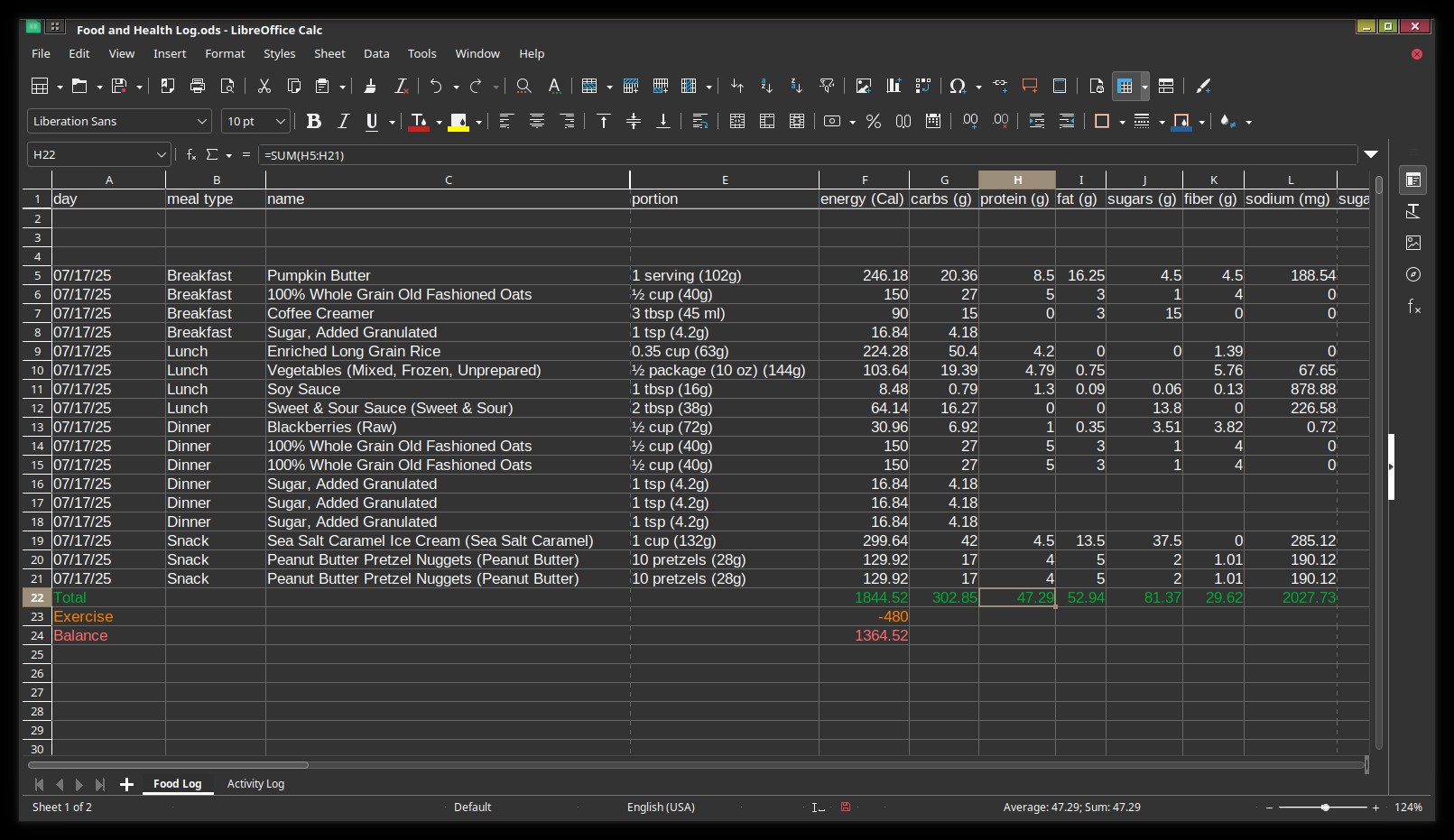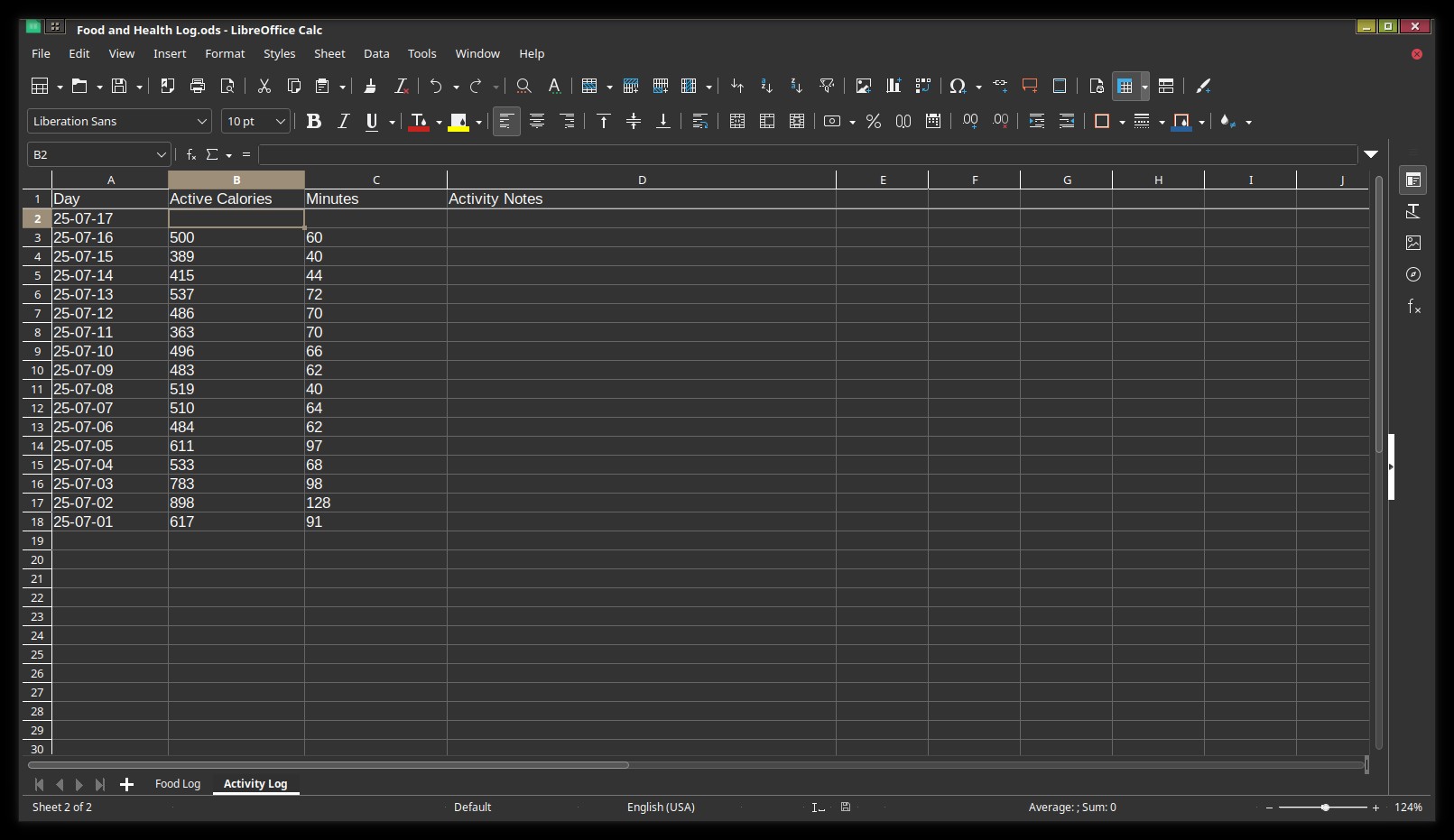Apple to GNU/Linux Journal: Food and exercise tracking
2025-07-17
Ten years ago, after a short period of weight gain, I decided I needed to get in the habit of better tracking my diet and exercise. I used an app (or, a series of different apps) on the iPhone to do the diet tracking and an Apple Watch for the exercise tracking. I don’t think I’ve missed a day of entering in my food in that 10 years. And while I still use the iPhone and Apple Watch, I’ve decided to begin the transition to a non-Apple process for these tasks. I’m sort of experimenting at the moment.
Step One: Downgrade the role of the Phone As a part of the larger process of disconnecting from Apple Services. I’d already turned off iCloud syncing as a part of stepping down to the free tier of iCloud a couple months ago. Step two was to turn off any analytics sharing with Apple and I’ve done that with everything on all my Apple devices so that’s not just related to the health tracking. I’m also making it a point to just keep the phone in airplane mode, wifi/cellular off except when needed. So, it’s mostly just sitting on a shelf. lol.
Step Two: Transition the data collection/storage to a computer I’ve been using an iPhone app called FoodNoms for the past 7 years so first thing was to export that to a csv file. I had no idea what the export would look like or how useful it would be. Turns out, it was really useful and a good starting point for my new system.

I opened that csv file in LibreOffice Calc and flipped the sorting so that the most recent entries would be at the top. Right off, I’m just going to say, this new process will not be as easy as the phone-based tracking. Nor will it have the nice infographics I get with the phone apps. That’s okay! While some of the charts are useful the truth is that I’ve learned most of it is eye candy. At the end of the day it’s a lot of fluff I don’t actually need. The key bit is that 6 years of data are right there for me to use going forward.
Spreadsheets, spreadsheets, spreadsheets! I’m a data nerd. In years past I built custom databases with FileMaker Pro for all sorts of things from invoicing to local plant surveys to recording astronomical observations. Several years ago I began to realize I was less interested in keeping up with new versions of FileMaker and that my data was somewhat trapped in those proprietary databases. I wondered if I could move it all to spreadsheets. For the most part that worked and I moved everything to another proprietary app, Apple’s Numbers. I thought, I’ll always use Numbers. On the upside, it’s been fairly easy to transtion from Numbers to Libre Calc. Mostly just exporting to Excel files then opening in Libre Calc and saving to ods files which can be opened on any computer.
Let’s take a moment to compare how this looks in terms of data security, backups and longevity. The Apple-device based tracking was being accomplished in Apple’s Health and Fitness apps along with FoodNoms. Without iCloud my data was not getting backed up. Looking at my phone, it reports the following storage use:
Apple Health: 5.5 GB Foodnoms: 994 MB Fitness: 126 MB
The real doozy here is that 5.5 GB used by the Health app. It tracks a bonkers amount of health data. BONKERS. All of the Foodnoms data is wrapped up in there. As is all of the exercise data. How does it add up to 5.5 GB? Well, as an example, if I open up the app and navigate to Active Energy, which is just one of many different sections of data collection, I can view “Show All Data”. That reveals a daily breakdown of daily active energy. If I click on a day I am treated to that day’s data and oh my, is that a doozy. Each days has hundreds of entries just for that category. The watch is sending data constantly, every few minutes there is a data record for active energy. If you wear an Apple Watch do yourself a favor: Open up the Health app on the iPhone and spend an hour really looking at the vast store of data that you are likely sending to Apple servers. Every minute of every day, all the data from your heart rate to your sugar intake.
So, yeah, it’s no surprise then that that one app is storing 5 GB of data. BONKERS. There’s likely a lot more that could be said about this but for now, for the purpose of this post, I’ll move on.
The spreadsheet I’ll be using going forward is currently 3.5 mb and will sync between my two computers and backed up to a local drive. At this starting point I’ve got the daily diet log on one sheet and an activity log on a second sheet.
Recording food is pretty straight forward in my case because my food is homemade from scratch, often the same meal repeated often. It’s easy for me to Copy/Paste rows from day to day. Chances are very good that today’s food intake is nearly identical to yesterday. When it changes it’s likely to a food I had at some point in the past week or month. Today I had blackberry oatmeal for dinner so I did a quick keyword search for blackberries and a couple seconds later copy/pasted the row into today’s entry. Super fast and about as easy as entry into the phone app.

Recording the day’s exercise is just a matter of looking at the phone for the data. My primary practice is to balance each day to about 1500 calories of intake, keeping an eyen on carbs and sodium. Because my diet follows a pattern the default is for everything to be about the same. When I do change things up having the data in front of me ensures that my goals are being met. I really just need those few essentials. I’ve got more if I need it but I rarely look.
I won’t have the minute-to-minute data I have on the phone but I don’t actually need that. I’ve been tracking my sleep for a few years and I’ve hardly looked at it. Most days I have a fairly good understanding how well I slept and if I got in close to what I want in the way of sleep.
For now I’ll continue dual entry into the phone apps and spreadsheet. But at some point in the not too distant future I’ll just use the spreadsheet. I’m not sure what I’ll do when the Apple Watch stops working. It’s 7 years old. Right now the battery still seems to be doing well but at some point in the next year or two it will degrade. I have a pretty good idea of what’s going on with my body after 7ish years of fairly close monitoring of my activity. I know that if I walk take a 30 minute, 1 mile walk on the gravel road I’ll burn around 125 calories. If I take a 50 minute trail walk I burn around 200 calories. Outside chores vary by intensity but I usually guess pretty accurately by duration and exertion how many calories were burned. I’m not sure I need a heart rate monitor anymore. I can get a fairly accurate number by just recording what I’ve done and for how long. And I have a $15 scale to get my weight every few weeks.
I’m fairly certain this will prove to be a fairly manageable, future-proof solution that’s easy to update and back-up. I may put together a third sheet in the spreadsheet that presents some sort of daily summary though I’m not sure that’s something I’ll need.
I don't have comments but I love email or you can find me on Mastodon.
Share this post
